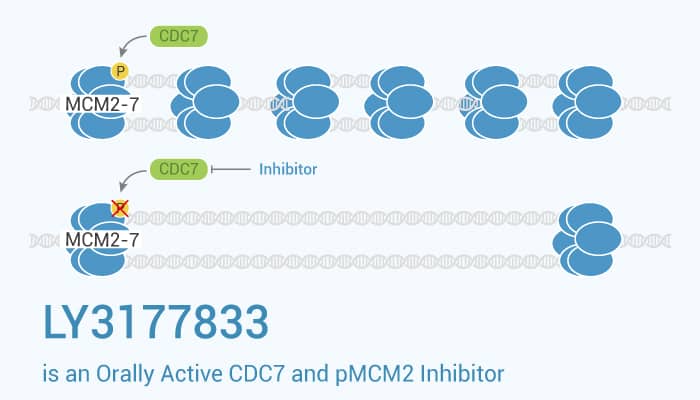CDC7 is a serine/threonine kinase and plays an important role in the initiation of DNA replication. . In this article, we will introduce a potent CDC7 and pMCM2 inhibitor LY3177833.
LY3177833 has an IC50 of 3.3 nM against CDC7. Upregulation of CDC7 has been observed in numerous tumor cell lines.
In Female athymic Balb/c nude mice with SW620 cells, LY3177833 causes significant tumor regression in a dose-dependent manner. Additionally, LY3177833 exhibits no tumor growth observed for 2 weeks after dosing cessation. As a result, this compound provides dose-dependent antitumor activity in an SW620 mouse xenograft tumor model.
Aging is the time-dependent decline in physiological function, additionally, it also has been the most serious risk factor for numerous diseases. As a result, the progressive accumulation of senescent cells acts as a key contributing factor toward aging. senescence-associated β-galactosidase (SA-β-gal) is the gold standard for senescence detection.

Proposed SRA141 Mechanism of Action
In a senescence model of human hepatocellular carcinoma cells (Hep3B) with the increase of SA-β-gal content, Hep3B cells are incubated with DNA-replication kinase CDC7 inhibitor LY3177833. LY3177833 acts as a senescence inducer. And it induces SA-β-gal expression. Additionally, inhibition of CDC7 induces a senescent phenotype in TP53 mutant liver cancer cells. LY3177833 impaired proliferation and induced senescence in TP53 mutant liver cancer cells. However, it has no effects on TP53 wild-type cells. What’s more, the Phosphorylation of MCM2 is a target of CDC7. LY3177833 also leads to suppressed p-MCM2 in TP53 mutant liver cancer cells. CDC7 inhibition also results in a significant increase in the duration of mitosis.
All in all, LY3177833 is a potent CDC7 inhibitor with anti-tumor activity. Besides, it is also a senescence inducer.
Reference:
[1]Li X, et al. Chem Sci. 2020 Jun 17;11(28):7292-7301.
[2] Cun Wang, et al. Nature. 2019 Oct;574(7777):268-272.